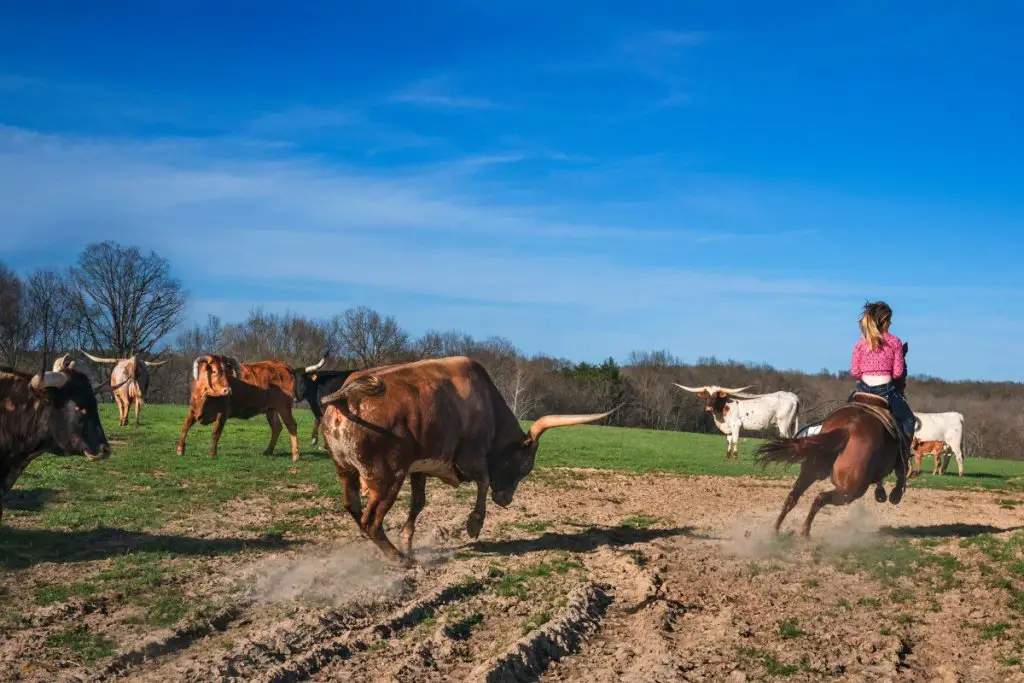Bulls are dangerous and entering paddocks requires vigilence. While they might appear gentle, they have fast reflexes and can run much faster than a human. Some breeds are more docile than others, and all breeds give signs that they're ready to charge.
It’s important to be careful when handling all farm animals, but this is especially true of bulls. An adult bull is a large and intimidating animal that can weigh up to around 2,000 pounds, and are known for their incredible strength, agility, and high levels of aggression.
Table of Contents
Bulls CAN Be Dangerous
While bulls can appear gentle, they have incredibly fast reflexes, and all it takes is one swift turn for them to cause serious injury. Always regard your bulls as dangerous animals and proceed with caution for your own health and safety.
Bulls will usually only attack when they are scared or territorial. Young bulls will look out for heifers and calves on a dairy farm, so it is likely that they will be especially territorial and protective.
Bulls WILL attack completely unprovoked, which is why you always need to be on guard around them and look out for aggressive animal behaviors.

Despite their immense size and strength, cows are a prey species. They are instinctively always on the lookout for potential threats and are prone to panic due to this stress.
In general, beef bulls will be less aggressive than dairy bulls. Holstein Friesians and Jersey bulls are known to be some of the more aggressive species to watch out for. If a newborn calf is male and won’t be used for breeding, it is more than likely they will be raised as beef cattle.
In this case, they will be castrated soon after their birth to reduce any unwanted mating and to make them more docile. A young bull that has been castrated is often referred to as a steer and will be expected to be less territorial and violent when around other bulls and cows.
According to studies and reports from the U.S. Department of Labor Census of Fatal Occupational Injuries and the Surveillance of Occupational Injuries and Illnesses, bulls are the cause of nearly 50% of all cattle-related deaths.
Common Signs That A Bull Will Charge
There are many warning signs that might indicate when a bull is poised to charge:
- Pawing The Dirt – An aggravated bull will stop their front feet into the dirt and kick it up behind them. Pawing at the dirt is both to display their readiness to whatever they’re planning on charging at, but could also be partly to test the terrain before they charge.
- Growling or Grunting – Bulls make deep, guttural sounds with their voice when they are getting ready to charge.
- Lowering His Head – Aggressive bulls will lower their head towards the ground to both show off their horns and also use their horns to dig into the ground and toss dirt upwards. This is an intimidation method where they hope to display their horns as a threat.
- Standing Sideways – In order to show you their size and strength, a bull will position themselves perpendicular to you. If you notice that a bull that was previously facing forward towards you has turned sideways, that’s a sign that they’ve entered a state of fight or flight and that it is best to start slowly backing away.
- Arched Posture – Once the bull has turned to stand broadside to you and has also lowered its head, you’ll notice that his posture will resemble an arch. At this point, they are in the proper stance to lash out or charge. Proceed with incredible caution once a bull has entered this stance.
Entering A Paddock With A Bull
Always enter a paddock with caution when approaching a bull. As is true of all cattle, they startle incredibly easily and will react with abrupt, sudden movements. When you’re in the presence of a bull, make sure that every move you make is well intended and careful in order to keep the animal calm.
Never turn your back on a bull. Because they are so sensitive and territorial, you never know when a bull might decide to strike. Even if a mature bull appears to be calm and docile, always be aware of their every movement until you are safely outside of their enclosure.
Always have an escape route planned in case of an attack. Bulls have what is known as a flight zone, which is basically their radius of personal space.
When you enter this zone, a bull should calmly turn to you or slowly move away. If they instead turn horizontally and start to exhibit a posture that they might charge, slowly back away while facing the bull.
Don’t make any loud noises or try to physically restrain and hurt the bull. This won’t effectively calm them or scare them into submission. They will only grow more agitated and dangerous to be around.
FAQs
What Should You Do If A Bull Charges You?
Try your best to dodge the attack to the side and then run quickly past the bull in the other direction. Staying near a fence or gate in the paddock is your best option for escape, as you can quickly jump up and climb over them.
Whatever you do, don’t try and retaliate by attacking the bull in return. More often than not, you won’t be strong enough and your reflexes won’t be quick enough to effectively subdue the animal.
Do Bulls Hate The Color Red?
In the Spanish tradition of bullfighting, the matador is often seen waving a red cape. Because of this, there is a common misconception that bulls are afraid of or hate the color red.
In reality, bulls are colorblind. The movement of the cape is what draws their attention, and not the actual color of the cape, so wearing a red shirt on your farm is OK.
